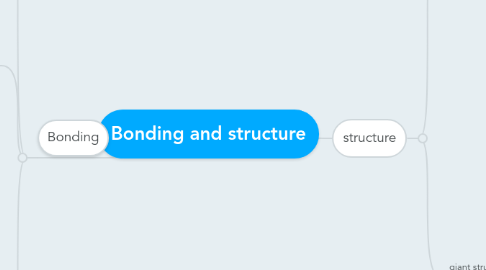
1. Bonding
1.1. Ionic bonds
1.1.1. involved metals and non-metals
1.1.2. exist in compounds only
1.1.3. meaning
1.1.3.1. the electrostatic attraction betwwen cations and anions in an ionic compounds
1.1.4. Formation
1.1.4.1. By rransfer of electrons from metal atom to non-metal atom
1.1.4.2. atoms lose or gain electrons to attain the stable electronic arrangement of noble gases
1.1.4.2.1. lose electrons
1.1.4.2.2. gain electrons
1.1.5. nature of bond
1.1.5.1. Electrostatic Non-directional
1.1.6. Constituent particles in the resultant structure
1.1.6.1. Ions
1.2. Metallic bonds
1.2.1. involved metals only
1.2.1.1. Metals are good conductors of the electricity because they have delocalized electrons
1.2.2. exist in elements only
1.2.3. meaning
1.2.3.1. the electrostatic attraction between the metal ions and the delocalized electrons
1.2.4. Formation
1.2.4.1. The valence shell electrons become delocalized, forming a sea of electrons surrounding the metal ions
1.2.4.2. In a metal, each atom gives up its electrons in the outermost shell and becomes a cation
1.2.5. nature of bond
1.2.5.1. Elecrostatic Non-directonal
1.2.6. Constituent particles in the resultant structure
1.2.6.1. Atoms
1.3. Covalent bonds
1.3.1. involved non-metals only
1.3.2. exist in elements and compounds
1.3.3. Formation
1.3.3.1. By sharing of electrons between atoms of non-metals
1.3.3.2. Atoms of non-metals share with each other in order to attain the stable electronic arrangement if noble gases
1.3.4. nature of bond
1.3.4.1. Electrostatic Directional
1.3.5. Constituent particles in the resultant structure
1.3.5.1. Molecules
1.3.5.2. Atoms
1.3.6. bonds
1.3.6.1. single bond
1.3.6.1.1. formed when one pair of electrons is shared between two atoms
1.3.6.2. multiple bonds
1.3.6.2.1. double bonds
1.3.6.2.2. triple bonds
1.3.6.3. dative covalent bond
1.3.6.3.1. When both electrons in the bond pair are contributed by the same atom, the covalent bond is known as a dative bond
1.3.6.3.2. as strong as normal single covalent bond
1.3.6.3.3. atoms that have lone pairs of electrons can form dative bond
2. structure
2.1. molecular structure
2.1.1. simple molecular structure
2.1.1.1. molecules are held together by weak intermolecular forces ( or vander Waals; forces)only
2.1.1.2. no chemical bond exists between molecules
2.1.1.3. properties
2.1.1.3.1. low melting point and boiling point
2.1.1.3.2. soft substances
2.1.1.3.3. Insoluble in water
2.1.1.3.4. soluble in non-aqueous solvents
2.1.1.3.5. Non-conductors of eletricity
2.2. giant structure
2.2.1. giant covalent structure
2.2.1.1. properties
2.2.1.1.1. Very high melting point and boiling point
2.2.1.1.2. Very hard
2.2.1.1.3. Insoluble in water
2.2.1.1.4. Non-conductors of electricity (expect graphite)
2.2.1.1.5. solid at roon temperature
2.2.2. giant ionic structure
2.2.2.1. properties
2.2.2.1.1. high melting and boiling point
2.2.2.1.2. hard and brittle
2.2.2.1.3. mostly soluble in water
2.2.2.1.4. conduct electricity when molten or when dissolved in water
2.2.3. giant metallic structure
2.2.3.1. properties
2.2.3.1.1. most metals have melying points and boiling points
2.2.3.1.2. good conductors of electricity
2.2.3.1.3. good conductors of heat
2.2.3.1.4. malleable and ductile
2.2.3.1.5. most metals have high density
